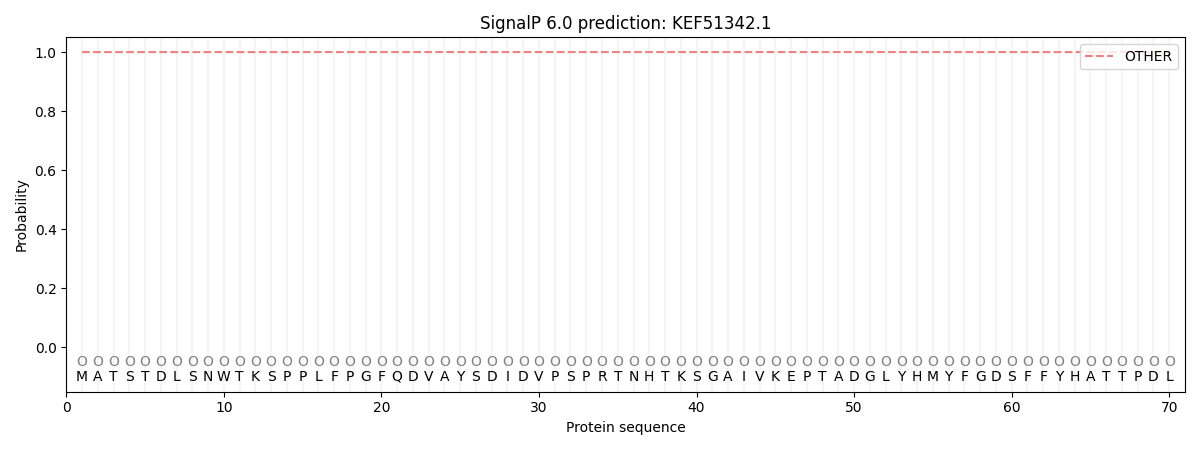You are browsing environment: FUNGIDB
CAZyme Information: KEF51342.1
You are here: Home > Sequence: KEF51342.1
Basic Information |
Genomic context |
Full Sequence |
Enzyme annotations |
CAZy signature domains |
CDD domains |
CAZyme hits |
PDB hits |
Swiss-Prot hits |
SignalP and Lipop annotations |
TMHMM annotations
Basic Information help
| Species | Exophiala aquamarina | |||||||||||
|---|---|---|---|---|---|---|---|---|---|---|---|---|
| Lineage | Ascomycota; Eurotiomycetes; ; Herpotrichiellaceae; Exophiala; Exophiala aquamarina | |||||||||||
| CAZyme ID | KEF51342.1 | |||||||||||
| CAZy Family | AA1 | |||||||||||
| CAZyme Description | unspecified product | |||||||||||
| CAZyme Property |
|
|||||||||||
| Genome Property |
|
|||||||||||
| Gene Location | ||||||||||||
CAZyme Signature Domains help
| Family | Start | End | Evalue | family coverage |
|---|---|---|---|---|
| GH130 | 1 | 186 | 5.6e-26 | 0.5135135135135135 |
CDD Domains download full data without filtering help
| Cdd ID | Domain | E-Value | qStart | qEnd | sStart | sEnd | Domain Description |
|---|---|---|---|---|---|---|---|
| 350122 | GH130_BT3780-like | 1.49e-57 | 1 | 186 | 106 | 275 | Glycosyl hydrolase family 130, such as beta-mammosidase BT3780 and BACOVA_03624. This subfamily contains glycosyl hydrolase family 130, as classified by the carbohydrate-active enzymes database (CAZY), and includes Bacteroides enzymes, BT3780 and BACOVA_03624. Members of this family possess 5-bladed beta-propeller domains similar to families 32, 43, 62, 68, 117 (GH32, GH43, GH62, GH68, GH117). GH130 enzymes are involved in the bacterial utilization of mannans or N-linked glycans. GH130 enzymes have also been shown to target beta-1,2- and beta-1,4-mannosidic linkages where these phosphorylases mediate bond cleavage by a single displacement reaction in which phosphate functions as the catalytic nucleophile. However, some lack the conserved basic residues that bind the phosphate nucleophile, as observed for the Bacteroides enzymes, BT3780 and BACOVA_03624, which are indeed beta-mannosidases that hydrolyze beta-1,2-mannosidic linkages through an inverting mechanism. |
| 350119 | GH130 | 6.10e-22 | 2 | 187 | 95 | 243 | Glycoside hydrolase family 130. Members of the glycosyl hydrolase family 130, as classified by the carbohydrate-active enzymes database (CAZY), are phosphorylases and hydrolases for beta-mannosides, and include beta-1,4-mannosylglucose phosphorylase (EC 2.4.1.281), beta-1,4-mannooligosaccharide phosphorylase (EC 2.4.1.319), beta-1,4-mannosyl-N-acetyl-glucosamine phosphorylase (EC 2.4.1.320), beta-1,2-mannobiose phosphorylase (EC 2.4.1.-), beta-1,2-oligomannan phosphorylase (EC 2.4.1.-) and beta-1,2-mannosidase (EC 3.2.1.-). They possess 5-bladed beta-propeller domains similar to families 32, 43, 62, 68, 117 (GH32, GH43, GH62, GH68, GH117). GH130 enzymes are involved in the bacterial utilization of mannans or N-linked glycans. Beta-1,4-mannosylglucose phosphorylase is involved in degradation of beta-1,4-D-mannosyl-N-acetyl-D-glucosamine linkages in the core of N-glycans; it produces alpha-mannose 1-phosphate and glucose from 4-O-beta-D-mannosyl-D-glucose and inorganic phosphate, using a critical catalytic Asp as a proton donor. |
| 225063 | COG2152 | 1.30e-14 | 1 | 185 | 123 | 273 | Predicted glycosyl hydrolase, GH43/DUF377 family [Carbohydrate transport and metabolism]. |
| 350124 | GH130_Lin0857-like | 6.56e-14 | 65 | 185 | 139 | 233 | Glycoside hydrolase family 130 such as Listeria innocua beta-1,2-mannobiose phosphorylase. This subfamily contains the glycosyl hydrolase family 130 (GH130), as classified by the carbohydrate-active enzymes database (CAZY), enzymes that are phosphorylases and hydrolases for beta-mannosides, and includes Listeria innocua beta-1,2-mannobiose phosphorylase (Lin0857). hey possess 5-bladed beta-propeller domains similar to families 32, 43, 62, 68, 117 (GH32, GH43, GH62, GH68, GH117). GH130 enzymes are involved in the bacterial utilization of mannans or N-linked glycans. Structure of Lin0857 shows beta-1,2-mannotriose bound in a U-shape, interacting with a phosphate analog at both ends. Lin0857 has a unique dimer structure connected by a loop, with a significant open-close loop displacement observed for substrate entry. A long loop, which is exclusively present in Lin0857, covers the active site to limit the pocket size. |
| 397932 | Glyco_hydro_130 | 1.52e-13 | 1 | 185 | 126 | 277 | beta-1,4-mannooligosaccharide phosphorylase. This is a family of glycosyl-hydrolases of the CAZy GH130 family. Several have been characterized as mannosylglucose phosphorylase. This enzyme is part of the mannan catalytic pathway and feeds into the glycolysis cycle. Specifically it catalyzes the reversible phosphorolysis of beta-1,4-D-mannosyl-N-acetyl-D-glucosamine. This family was noted to belong to the Beta fructosidase superfamily in. |
CAZyme Hits help
| Hit ID | E-Value | Query Start | Query End | Hit Start | Hit End |
|---|---|---|---|---|---|
| 3.09e-91 | 1 | 185 | 177 | 367 | |
| 1.75e-53 | 1 | 185 | 143 | 311 | |
| 2.57e-42 | 2 | 185 | 170 | 323 | |
| 3.89e-38 | 1 | 185 | 138 | 312 | |
| 4.59e-38 | 1 | 185 | 162 | 321 |
PDB Hits download full data without filtering help
| Hit ID | E-Value | Query Start | Query End | Hit Start | Hit End | Description |
|---|---|---|---|---|---|---|
| 8.13e-16 | 1 | 186 | 148 | 324 | Crystal structure of a putative glycoside hydrolase (BACOVA_02161) from Bacteroides ovatus ATCC 8483 at 1.85 A resolution [Bacteroides ovatus ATCC 8483] |
|
| 4.73e-14 | 1 | 179 | 147 | 316 | Crystal structure of a putative glycoside hydrolase (BDI_3141) from Parabacteroides distasonis ATCC 8503 at 1.70 A resolution [Parabacteroides distasonis ATCC 8503] |
|
| 5.29e-14 | 1 | 186 | 173 | 349 | The GH130 family of mannoside phosphorylases contains glycoside hydrolases that target beta-1,2 mannosidic linkages in Candida mannan [Bacteroides thetaiotaomicron] |
|
| 5.29e-14 | 1 | 186 | 173 | 349 | The GH130 family of mannoside phosphorylases contains glycoside hydrolases that target beta-1,2 mannosidic linkages in Candida mannan [Bacteroides thetaiotaomicron] |
Swiss-Prot Hits help
SignalP and Lipop Annotations help
This protein is predicted as OTHER

| Other | SP_Sec_SPI | CS Position |
|---|---|---|
| 1.000058 | 0.000001 |
